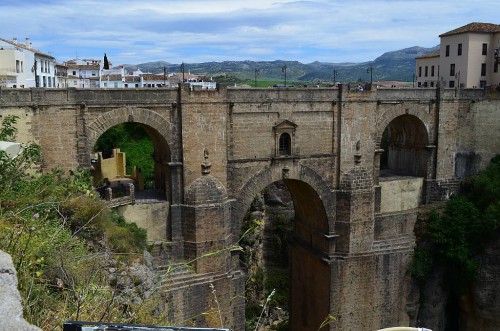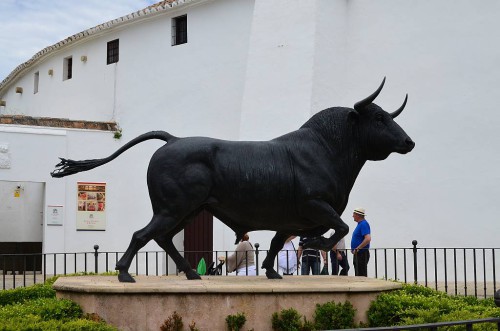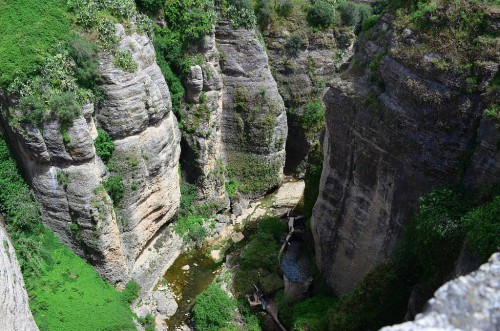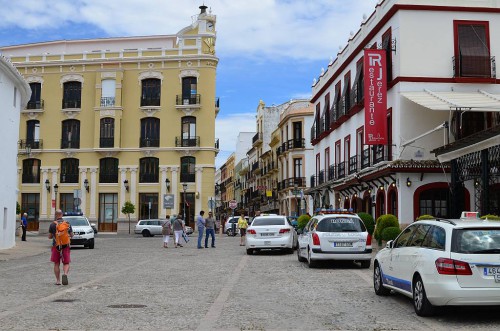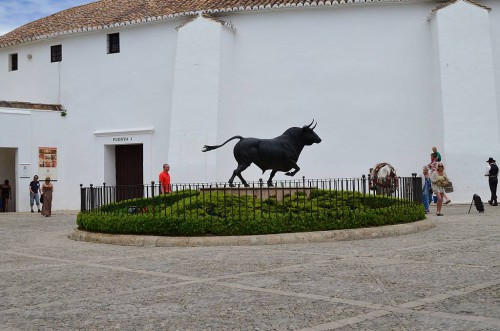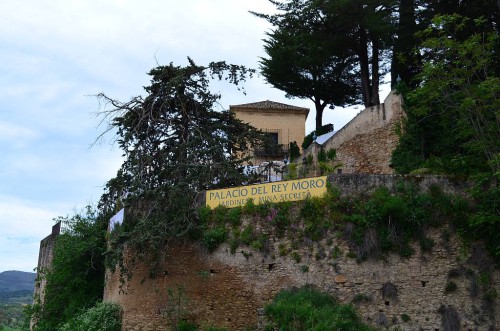Ronda is one of Andalucia’s most picturesque towns and well worth a visit. It stands on a plateau high in the mountains and is famous for its magnificent river gorge. The gorge, which splits the town into two distinct areas, medieval and 18th century, is known as El Tajo (The Cliff) and is spanned by a stone bridge which once housed a prison.
Ronda also has its bullring, the oldest and possibly the largest in Spain. When there are no fights, the bullring is open to visitors and the museum exhibits many mementos of Spain’s most renowned bullfighters. See also Bullfighting
Ronda is about 2.5 hours drive from Nerja and 1 hour’s drive from San Pedro de Alcantara. The road winds up through the Sierra Bermeja mountains and the views are fantastic.
Location
Getting to Ronda
Taxi Transfers: You can book a transfer with RondaTaxiTransfers.com who are reccomended in the Ronda Transfer section of TripAdvisor.
Places of Interest
La Ciudad (Moorish citadel,)
This was the main entrance to the city and was once protected by towers.
Entry to the area is through the horseshoe-shaped Moorish Gate, Puerta de Almocábar. On the corner of this gate, the Almohad rulers erected an octagonal tower, destroyed by the Christians during their successful assault in 1485, and this spot is now marked by the Iglesia del Espiritu Santo, a church built by the victorious Christians to celebrate their victory on Whit Sunday, May 20th 1485.
To the west is the other surviving horseshoe-shaped arch, the Arco de Cristo. There is also an old Moorish minaret, renamed the Minaret of San Sebastián by the Christians.
The old city walls still stand and visitors can walk along them towards the bridge. Below, in a walled garden, is the well Moorish bath house, the Hammam. It is open to the public , free of charge, though not for bathing. Many of the old Moorish style buildings and small palaces survive and many are open to the public.
El Tajo (The Cliff) – River gorge dividing the medieval and 18th Century parts of town.
Puente Nuevo (New Bridge)
The bridge, started in 1751 and taking 42 years to complete, stands at height of 300 feet and was designed by architect José Martin de Aldehuela. Huge stone blocks had to be raised from the bottom of the gorge and this was an engineering feat in itself.
This was not the first bridge on this site. Records show that in the early 1730s, one was completed in just eight months by Juan Camacho and José Garcia. However, such was the perilous nature of their construction, it collapsed with the loss of some fifty lives.
Beneath the central arch is a chamber which was used, at one time, as a prison. It is entered via a square building which was once the guard-house. For a fee, visitors can enter the chamber and see an exhibition describing the bridge’s history and construction.
Plaza de España – Site of the Parador
Mirador – Viewpoint
Calle Nueva – Shopping precinct.
Bullring – Made famous by the legendary Pedro Romero
Casa del Rey Moro
Built in the 18th Century with gardens designed by the French landscape gardener Forestier in 1912, it houses the so-called Water Mine. In the 14th Century, Ronda was frequently besieged and the Moorish king, Abomelik, ordered the cutting of steps into the stone walls of the gorge to enable the bringing of water from the Río Guadelevin below. The crumbling staircase was restored in 1911.
The steps pass through a number of chambers including the Sala de Secretos (Room of Secrets). Originally designed to house a well, the Moors supposedly noticed that the room had one special characteristic. Two people standing close to the wall, but at opposite ends of the room, could speak perfectly well to each other without being audible to anyone standing in the middle of it.
The steps eventually lead the bottom of the gorge. It is quite a haul and bear in mind that the only way out is back up the 300 steps!!
Palacio de Mondragón – Museum devoted to the history of the area.
Plaza de Toros – Stone structure completed in 1784 and Spain’s oldest existing bullring.
The Alameda – Tree-lined avenue opened to the public in 1806.
The Carmelite Convent
Up the hill from the bullring is a flight of stone steps leading to the wooden doors of the Merced Carmelite Convent. The first Carmelites were male hermits, former pilgrims and crusaders who gathered together in 1155 AD at Mount Carmel in Palestine and dedicated themselves to a life of austerity, poverty and prayer.
There were also women who wanted a similar life and in 1452 John Soreth, Prior General of the Carmelites, officially affiliated the first nuns. The sisters in the convent , established in the 16th Century, belong to the Mercedarian order. It is a cloistered order devoted to prayer, penance and perpetual abstinence. Visitors are always welcome but the nuns’ privacy must be respected at all times.
Useful Info
Tourist Offices:
Plaza de Blas Infante s/n
29400, Ronda
Tel: 952 18 71 19
Fax: 952 18 71 47
Plaza de España 1
29400 Ronda
Tel: +34 952 871272
Ayuntamiento de Ronda: Tel: 95 287 3240
Ambulatorio Ronda Norte: Tel: 95 287 1760
Ambulatorio Ronda Sur: Tel: 95 287 4944
Fire Brigade: Tel: 95 287 1958
Post Office: Tel: 95 287 2557
Red Cross: Tel: 95 287 1464
Bus Station: Tel: 95 287 7061
Train Station: Tel: 95 287 1673
Train Tickets: Tel: 95 287 1662
Guardia Civil: Tel: 95 287 1461
Guardia Civil Trafico: Tel: 95 287 3290
Hospital General: Tel: 951065001 / 5000
Local Police: Tel: 092
National Police: Tel: 091
Taxi Rank: Tel: 95 287 2316 / 9185

